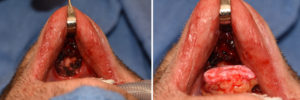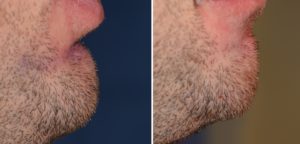Background: The labiometal fold is a feature of the lower third of the face on the chin that exists in varying degrees. Whole usually called a fold it is really a sulcus or indentation. The significance of its presence is determined by numerous factors which include the strength of its subdermal attachments, the size of the soft tissue chin pad and bone and the inclination of the lower teeth and lip position.
But in otherwise normal chins and mandibular incisor positions, a deep labiomental fold can still occur. This is presumably due to strong attachments between the underside of the dermis and the deeper muscle down on the bone. It may also be contributed to by the lack of thickness of the subcutaneous tissue layer.
While most people don’t give the appearance of their labiomental folds much thought, some with very deep folds are bothered by it. Such deep folds indentations below the lower lip seem to pull it in causing the outer roll of the lip to be lower. Deep folds also make the chin appear vertically short. Softening the depth of the labomental can be done successful by injectable filler, fat or even subnormal implants in mild cases but not in more deep cases.
Case Study: This 30 year-old male had alway been bothered by his very deep labiodental fold. He had not pursued any non-surgical injection therapies for it and opted for a more definitive surgical approach.


Highlights:
1) The attachments of the labiomental fold make it very difficult to reduce its depth by conventional means.
2) Release of the fold internally and the placement of an interpositional graft is needed to increase its projection. (labiomental fold reduction)
3) Multiple types interpositional grafts for the labiomental fold can be used of which one is a dermal-fat graft.
Dr. Barry Eppley
Indianapolis, Indiana


